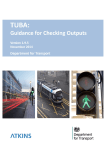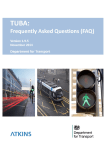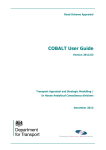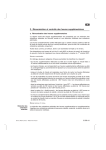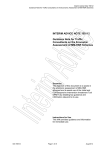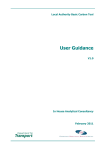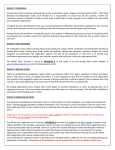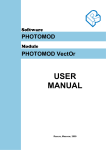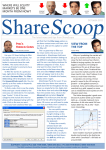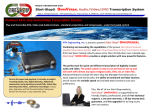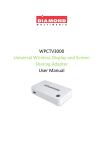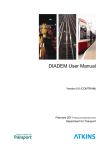Download Unit 6.5 Guidance on using TUBA
Transcript
Project Appraisal Guidelines Unit 6.5 Guidance on using TUBA August 2011 Project Appraisal Guidelines Unit 6.5 Guidance on using TUBA Version 1.0 Date August 2011 Comments New Guidance This document is available to download at www.nra.ie/publications/projectappraisal For further queries please contact: Strategic Planning Unit National Roads Authority St Martin’s House Waterloo Road Dublin 4 Tel: (01) 660-2511 Email: [email protected] Web: www.nra.ie NRA Project Appraisal Guidelines Unit 6.5: Guidance on using TUBA 1 Introduction 1.1 TUBA is a computer program used for undertaking transport economic appraisals. TUBA draws information directly from transport models, and applies economic parameters to calculate benefits and costs associated with travel time, vehicle operating cost and emissions changes. 1.2 This PAG Unit provides information on the processes required to undertake a TUBA assessment. It deals with data collection, the linkages with the traffic model, and the parameter values that should be used for assessments at the different phases of a road scheme. 1.3 This PAG Unit also provides advice on where to seek guidance on using the TUBA program and how TUBA assessments should be audited. 1.4 Note that TUBA does not calculate benefits that are due to changes in accident costs. The derivation of accident cost savings should be undertaken using the COBA program or using manual techniques based on standard parameter values 2 Data Requirements 2.1 TUBA has the flexibility for a number of input parameters to be modified by the user to better reflect local conditions. However, the use of standard values and relationships is central to the CBA concept and, at the early stages of scheme assessment, this avoids the need for time consuming and costly data collection exercises. 2.2 The decision to use local or national default values depends on the phase of the scheme assessment. At Route Selection, local values may be used where available, although national values are normally acceptable. However at Design Stage, local data should be input where it is both reliable and significantly different from national values. 2.3 TUBA Input data is presented in two distinct groups. These are: • • The economics file: this is a standard file for all TUBA runs. It contains all the basic economic data required such as value of time, value of cost, taxes, growth in costs, fuel consumption etc; and The scheme data file: this contains information regarding the specific scheme under consideration. This will include scheme costs, scheme years, vehicle types, time periods, modes, person types and details of the skimmed matrices to be input. Page | 1 NRA Project Appraisal Guidelines Unit 6.5: Guidance on using TUBA 2.4 For TUBA, scheme data is extracted directly from the traffic models. As such, the use of local or national data for information such as vehicle proportions, network information and speed flow relationships will have been defined prior to the development of the traffic models. Guidance from PAG Unit 5.2: Construction of Transport Models is therefore also relevant to TUBA appraisals. 3 The Economics File 3.1 The economics file is standard to most TUBA appraisals, with values linked to those set out in PAG Unit 6.11: National Parameter Values Sheet. 3.2 The following information may be changed in the economics file: • • • • Time Periods: Additional time periods may be defined as necessary to enable annual scheme impacts to be fully appraised; Vehicle Occupancy: Default values may be substituted with Local Values for Vehicle Occupancy if information is reliable, and differs significantly from national values; Default Purpose Split: Default values may be substituted with Local Values for Vehicle Purpose if information is reliable, and differs significantly from national values; Preparation and Supervision Costs: Default values may be substituted with scheme specific data at Phase 3 Design, Phase 5 Tender and Phase 7 Closeout. 3.3 All changes to the standard economics file will require consent of the NRA Strategic Planning Unit. 4 The Scheme Input File Scheme Specific Parameters 4.1 This first section provides basic information about the scheme. The user can specify the following: • • • • • • Scheme name; Scenario names; Modelled years; Current year; Scheme horizon year; and Number of warnings. Time Slices 4.2 The TUBA user can specify both the time periods modelled and the annualisation factors that will be used to convert the modelled periods to average annual equivalents. Descriptions of the time slices can be entered for each time slice specified. Time slices might comprise one or more of: • Single 1 hour time slice for an average AM peak hour; Page | 2 NRA Project Appraisal Guidelines • • • Unit 6.5: Guidance on using TUBA Hourly time slices across a period (e.g. 0700-0800, 0800-0900, 0900-1000); 30-minute time slices across a whole period; and Single hour time slices for a fixed time period. Annualisation Factors 4.3 To understand the full impacts of a modelled scheme it is necessary to extrapolate the data to represent a full year. A number of separate annualisation factors may need to be applied depending upon the modelled periods. The annualisation factor describes the factor that is applied to the various time slices to define a full year. Standard divisions of the year are used as follows: • • • 4.4 253 peaked weekdays; 52 weekends; and 10 bank holidays. The TUBA program should only be used to accrue benefits for those time periods modelled. For example, if only weekday peak periods have been modelled in the traffic modelling, then only weekday peak periods may be accounted in the accrual of annualised benefits. The inclusion of off peak and weekend time periods therefore should be considered if they are likely to contribute to the scheme business case. Scheme Costs 4.5 The preparation of scheme costs should follow the guidance set out in PAG Unit 6.7: Preparation Scheme Costs. The TUBA Input allows the total costs to be allocated amongst the various cost categories. 4.6 Costs can be included for the Do Minimum and Do Something scenarios. For many schemes, there will be no costs associated with the Do-Minimum option. Note that this is distinct from the Traffic management Option which should be appraised as one of a number of Do-Something alternatives. 4.7 Default spend profiles and allocation of costs to preparation and supervisions costs will be assumed unless specified otherwise. For any costs associated with construction or land acquisition, the relevant RPI will need to be applied to factor the costs to the purchase year. Scheme Data: User Classes 4.8 The TUBA user can specify the level of breakdown between different types of vehicle and user that will be appraised during the analysis. The level of detail that can be used depends mainly on the level of disaggregation provided by the traffic model, although default proportions for vehicle types and trip purposes can be requested. For each user class to be reported on the following needs to be specified: • • • Vehicle type/sub mode; Purpose; and Person type. Page | 3 NRA Project Appraisal Guidelines Unit 6.5: Guidance on using TUBA 4.9 The top-level of aggregation in TUBA is ‘mode’ which is then followed by ‘sub-mode’ (or vehicle type). For car, the ‘mode’ would be roadand the ‘sub-mode’ vehicle type i.e. car, LGV, OGV etc. For public transport, the ‘mode’ would be type of public transport i.e. rail, bus etc and the ‘sub-mode’ vehicle type i.e. light rail, heavy rail etc. 4.10 TUBA will automatically use the person types specified within the standard economic file to calculate the VOT per vehicle. Matrix Data 4.11 The input matrix data consists of ‘matrix skims’ from the relevant transport models. Data from both highway and public transport models (if appropriate) can feed into the TUBA run. Input matrices are always required for demand in each time period, and some or all of travel distance, travel time and user charges depending on the type of scheme being assessed. Separate skimmed matrices will be required for: • • • • Each modelled year; Each modelled time period; Each modelled mode; and Each user class. 4.12 The matrix data section of the scheme file gives a filename and pathname for each matrix data file, and informs TUBA of the type of data, the units of data and the format of the data included in the file. One line is required for each input matrix file. All standard transport modelling software is capable of producing costs in the required format for TUBA. 4.13 When inputting matrix files, each file requires classification as follows: • • • • • • • • • File number, entered in sequence for each file starting at 1; Userclass, referencing the user classes covered by the matrix in accordance with the information under the heading USER_CLASSES in the Scheme Input File; Timeslice, referencing the time slice covered by the matrix in accordance with the information under the heading TIME_SLICES in the Scheme Input File; Type, indicating the content of the matrix. (V=vehicle flows, T=time, D=distance, P=Passenger Trips, Cn=Charge,); Format, indicating the format of the matrix. Three matrix formats are available, for details see Appendix C of the TUBA User Manual; Scenario, where 0 = Do Minimum and 1 = Do Something; Year to which demand matrix relates; Factor applied to the matrix (this will normally be 1.0); Filename and path 5 TUBA Input Checks 5.1 Matrix definition is an important element of the scheme file and it is relatively easy to make errors in doing this. For example, a user can input a matrix corresponding to a different time period (e.g. a PM peak time matrix when the AM is required). Similarly, Page | 4 NRA Project Appraisal Guidelines Unit 6.5: Guidance on using TUBA matrices relating to different user classes can easily be confused - especially if file names are ambiguous. Such errors will not always be picked up by the checks described above; however they may become apparent in the next series of checks, which compare matrices from the Do-Minimum (DM) and Do-Something (DS). 5.2 TUBA also undertakes a check on the ratio (r) of Do Minimum to Do Something costs (time and distance) as follows: Table 6.5.1: Internal checks within TUBA Value of r Action r<0.33 or r>3.0 Serious warning 0.33<r<0.67 or 1.5<r<3.0 Warning 0.67<r<1.5 OK, no warning 5.3 These checks are made because, in the case of large changes in cost, the rule of a half which is used to calculate user benefits may not be valid. The TUBA Manual provides advice on how users should deal with situations when this is the case. It should also be borne in mind that large changes in costs may also be due to modelling errors and assumptions. For example, forecast delays at locations in the network could have been adversely influenced by inaccurate assumptions regarding traffic signal times. 5.4 Warnings and serious warnings therefore indicate possible anomalies in the input data and should be investigated. Errors will cause the TUBA calculation to stop and must be resolved before TUBA can run to completion. 6 The Scheme Output File 6.1 The output files from TUBA contain the following summary information: • • • • • • • 6.2 6.3 Warnings; Input summary; Scheme trips summary; Scheme costs summary; Total user costs; User benefits and revenues; and Economic efficiency of the transport system table (TEE). Warnings A warnings output file will appear at the beginning of the output results. This will detail both ‘serious’ and ‘non-serious’ warnings. A warning is triggered when the difference between the Do Minimum (DM) and Do-Something (DS) costs are outside the expected range. A ‘serious’ warning indicates that the difference between the DM and DS costs is so significant that a user check of the input data and parameters should be undertaken. Page | 5 NRA Project Appraisal Guidelines Unit 6.5: Guidance on using TUBA Input Summary 6.4 The second set of data that outputs from TUBA is a summary of the user inputs and/or input file. The key data summarised includes: • • • • • • • • Scheme file; Names of schemes; Standard economics file name; First year that the scheme incurs costs; First appraisal year; Last appraisal year; Modelled years; and Total time periods. Scheme Trips Summary 6.5 This provides a summary of all matrix totals as input by the user. Matrix totals are provided for each time slice and annualised. Data is provided separately for each user class. Scheme Costs Summary 6.6 This presents the scheme costs for the DM scenario, the DS scenario and the Present Value Costs. The DM scenario and DS scenario present all the cost types, undiscounted but with a market price adjustment and RPI factors added. The costs are presented in 2009 prices. Total User Costs 6.7 A DM and DS user cost gives the total costs for each scenario. This provides an overview of the total changes in cost between the two scenarios and allows an initial comparison to be made of the allocation of costs. This includes such indicators as: total time, total fuel consumption, total charges and total non-fuel costs. 6.8 The output also includes further detailed tables of the fuel and environmental costs of the schemes. User Benefits and Revenues 6.9 User benefits and revenues are reported in mode, sub-mode, person type, purpose and period. They show the user benefits and changes in user time, user public transport charges, fuel VOC, non-fuel VOC, operator public transport revenue and indirect taxes. 6.10 The figures are presented as plus and minus figures. A minus figure in the benefits values denotes a disbenefit to users. A minus figure in the revenues columns indicates a reduction in revenues. Page | 6 NRA Project Appraisal Guidelines Unit 6.5: Guidance on using TUBA Economic Efficiency of the Transport System Table (TEE) 6.11 The core output from the TUBA run is the monetised present value of benefits presented in the TEE table. This information is presented by trip purpose, by mode of transport and by impact (time, vehicle operating costs etc). 6.12 The key items used in the estimation of user benefits include: • Changes in travel time • Changes in user charges – fares, tariffs and tolls; and • Changes in vehicle operating costs as they apply to the user. 6.13 In the monetised costs and benefits table, there will be summaries of the following: • • • • • • • • • Consumer user benefits (costs/benefits to travellers not on business trips); Business user benefits (business or goods trips); Private sector provider benefits; Other benefits; Carbon benefits; Net present value of benefits; Net present value of costs; Overall summary net present value; and Benefit to cost ratio (BCR). 6.14 Note again that TUBA does not consider the cost of accidents. Inclusion of accident benefits in a TUBA appraisal requires the calculation of accident benefits by some other means (either manually or using COBA), and the incorporation of that output into the scheme appraisal results. 6.15 The TEE will form a core section of the overall appraisal document and will provide the core monetised assessment of costs and benefits. However, in addition to the quantitative evidence provided by the TEE table, any qualitative evidence should be noted in the Standard Appraisal Table. 7 Further Guidance 7.1 Further guidance on the use of TUBA is available at: http://www2.dft.gov.uk/pgr/economics/software/tuba/ • • • • 7.2 General guidance and advice on the application of TUBA: Obtaining the software and assistance in running it: Demonstrations: Frequently asked questions: News of the latest developments and updates for TUBA can be found at: http://www.dft.gov.uk/stellent/groups/dft_econappr/documents/sectionhomepage/dft_ econappr_page.hcsp Page | 7 NRA Project Appraisal Guidelines Unit 6.5: Guidance on using TUBA 8 Sensitivity 8.1 An important output from TUBA is the SENSITIVITY table. The information in this table can be used to assess the sensitivity of the user benefits to the level of convergence in the transport model. The smaller the numbers reported in this table, the more sensitive the results. WebTAG (UK) gives the following guidance on determining whether model convergence is adequate, given the size of the scheme benefits. “Convergence and scheme benefits. The required level of convergence needs to be linked to the scale of the benefits of the scheme being appraised, relative to the network size. For instance the calculation of benefits from small schemes in large networks will be much more sensitive to convergence than large schemes in small networks. On the basis of testing it has been discovered that ideally the user benefits, as a percentage of network costs, should be at least 10 times the % Gap achieved in the Do-Minimum and Do-Something scenarios. The estimation of user benefits can be estimated either by using matrix manipulation of the with and without scheme trip and skimmed generalised cost matrices to produce an estimate of the consumer surplus by the rule of a half, or by using TUBA program. In either case the worst case convergence of the ‘with’ and ‘without’ scheme runs should be taken as the one to compare with the size of the benefits”. Page | 8













